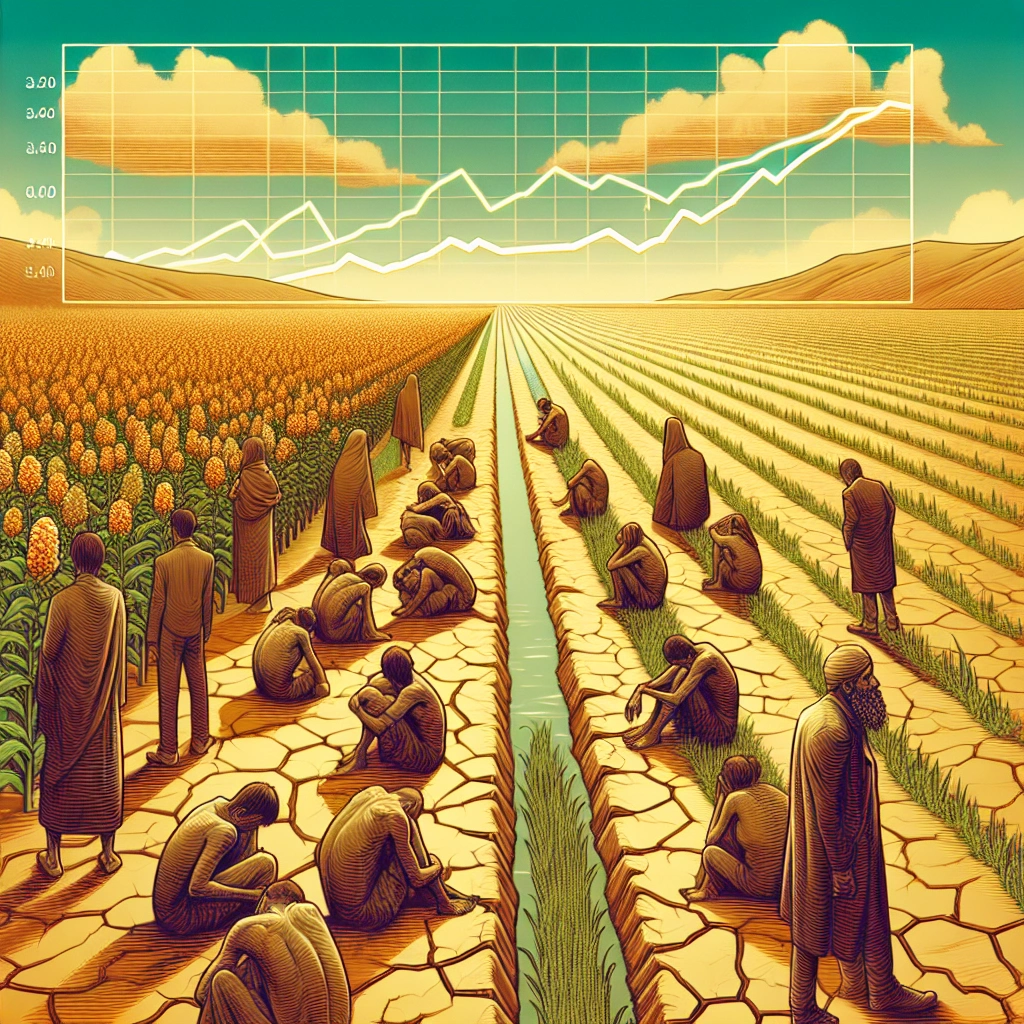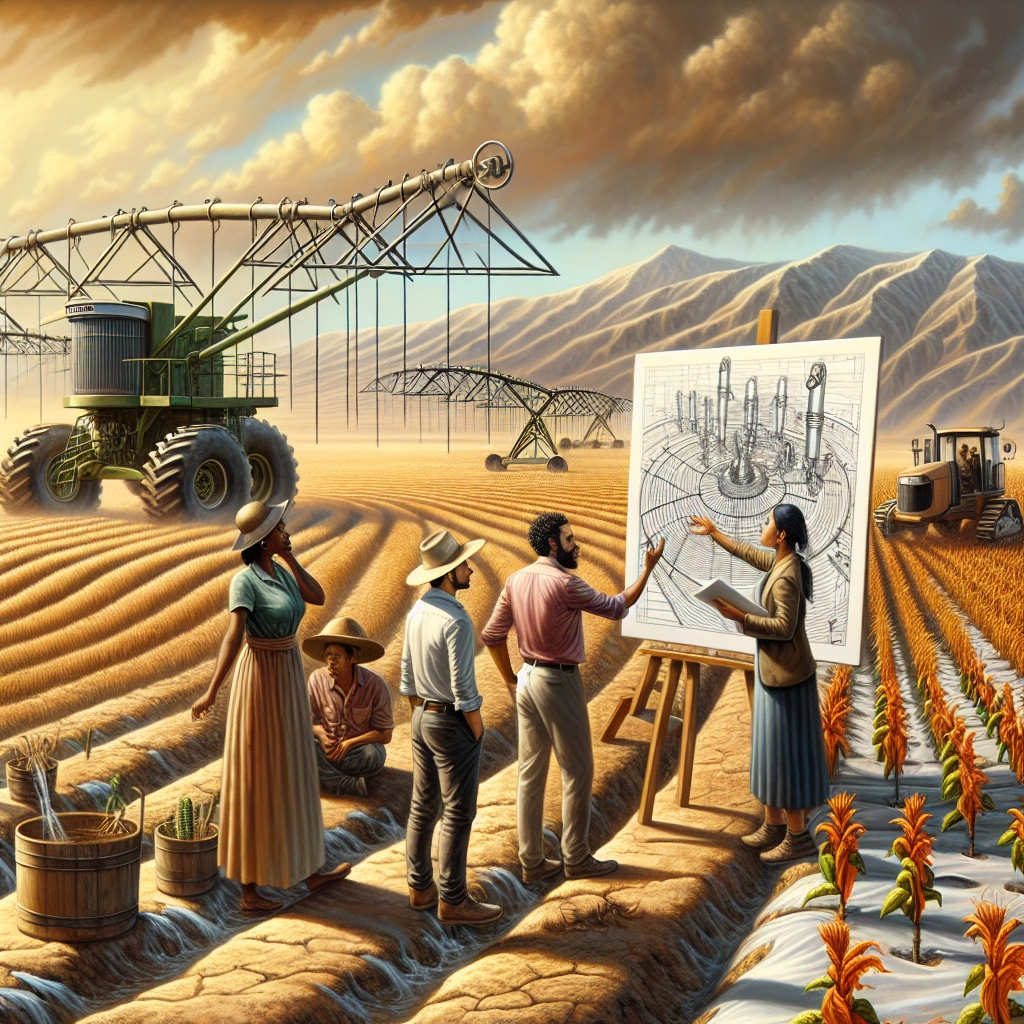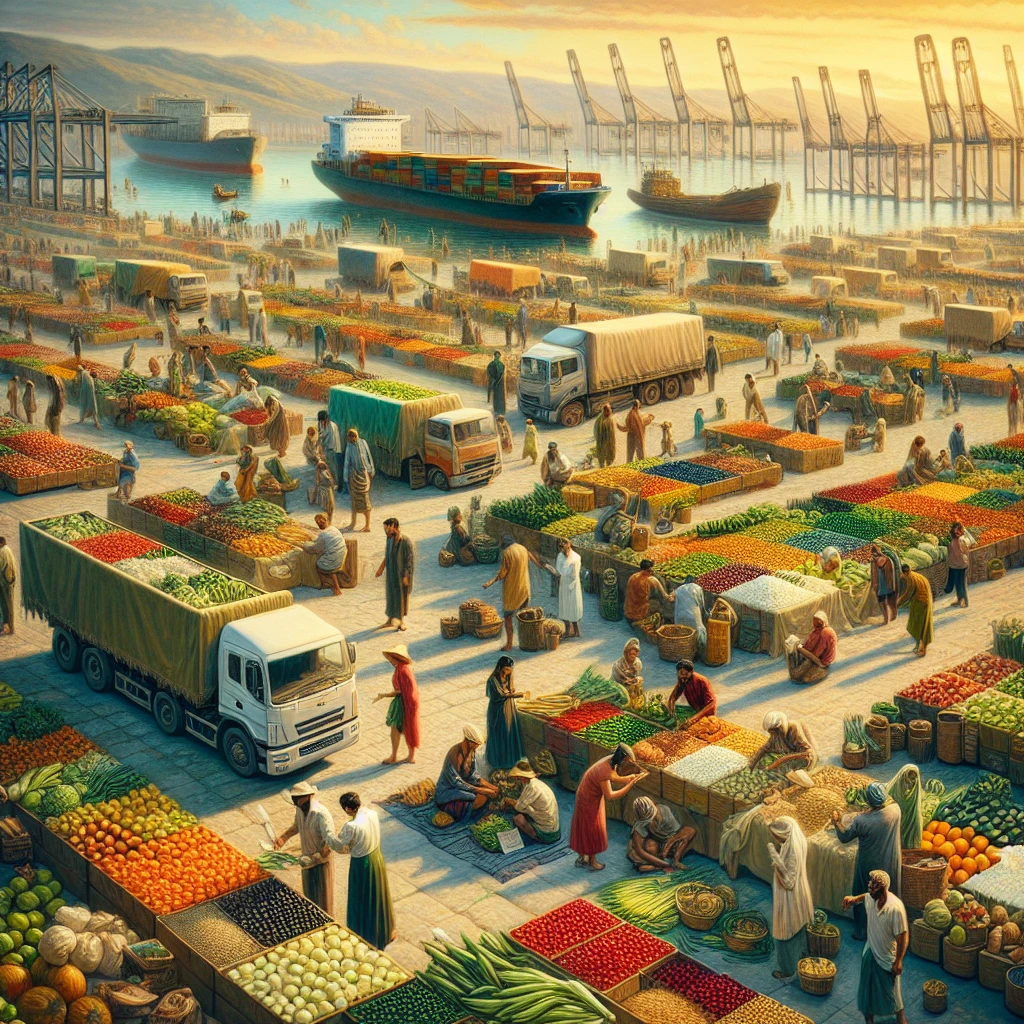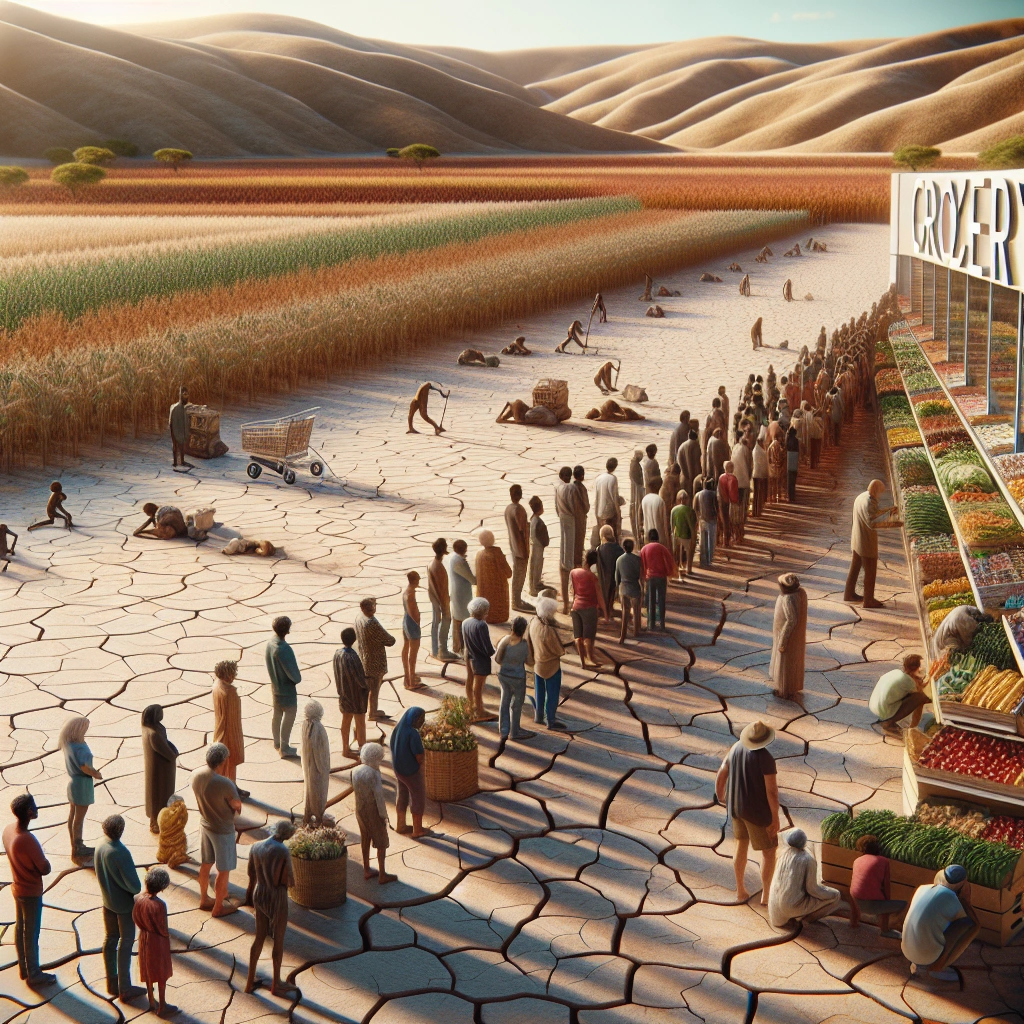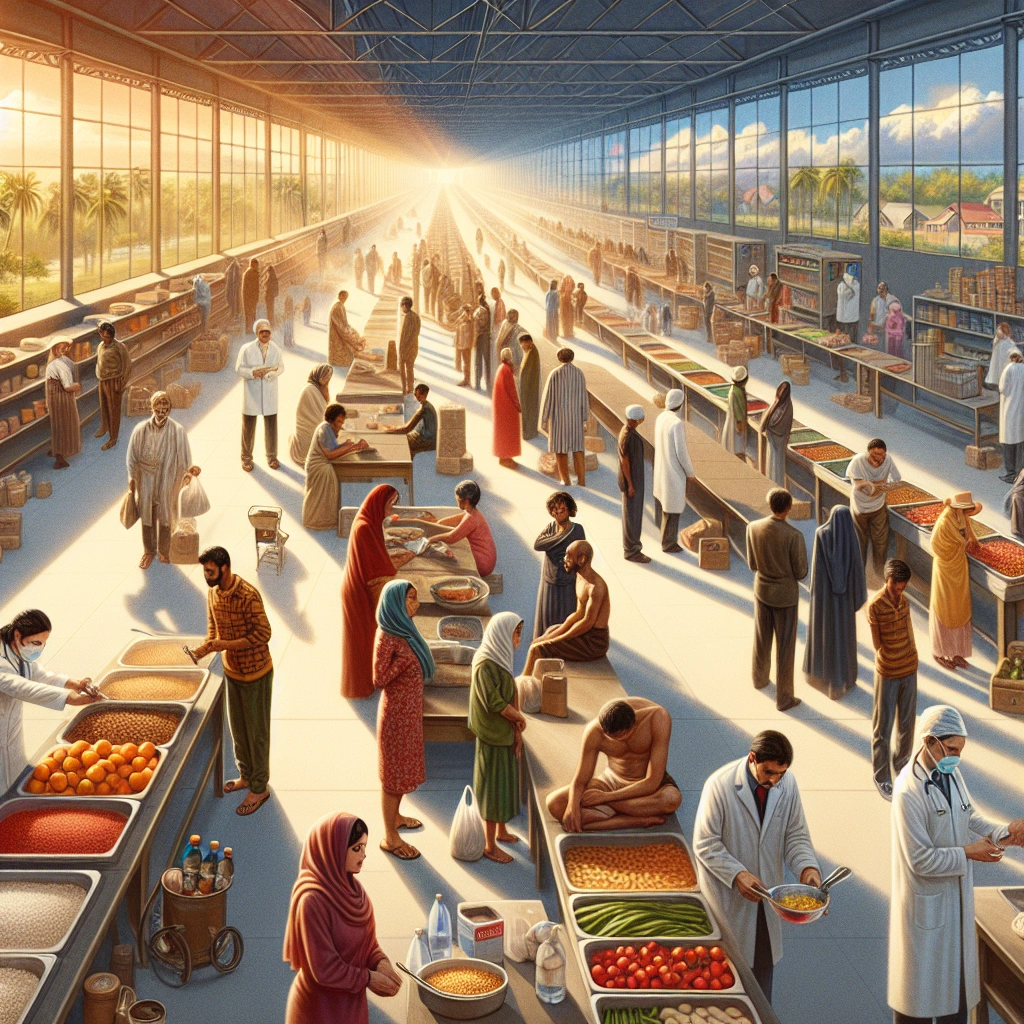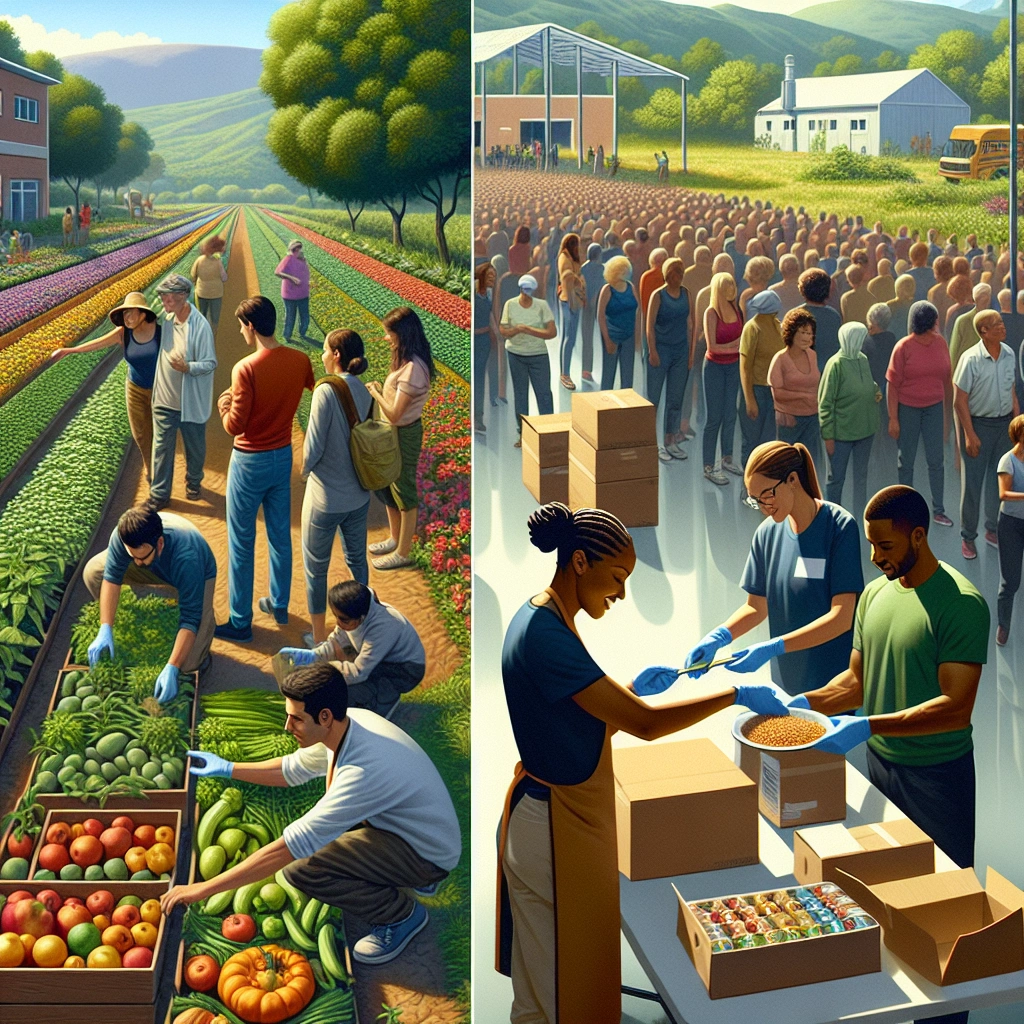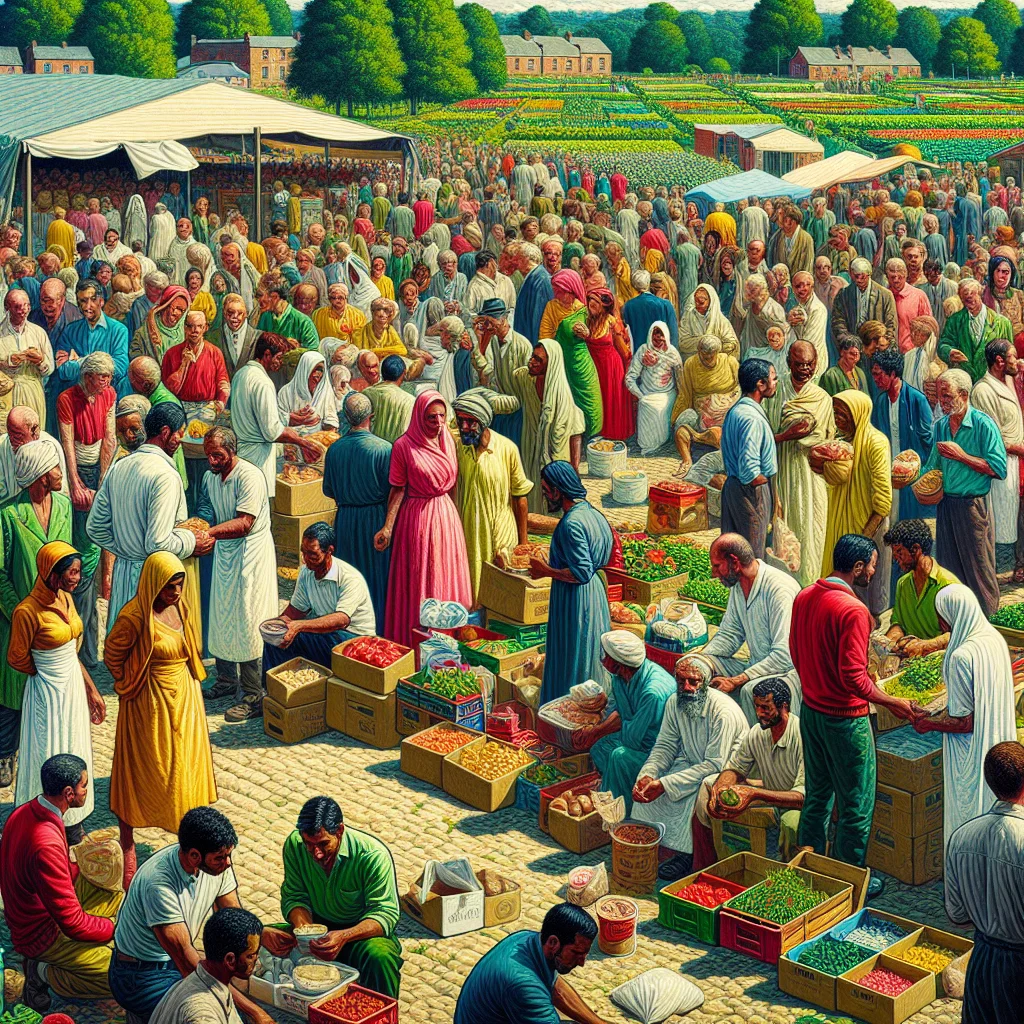

A food crisis occurs when rates of hunger and malnutrition rise sharply at local, national, or global levels. It is important to understand the causes and solutions of food crises in order to effectively address and prevent them in the future.
This topic is relevant and timely because the world is facing a global hunger crisis of unprecedented proportions, with millions of people at risk of acute food insecurity. Recognizing the causes and implementing solutions is crucial in order to save lives and ensure food security for all.
Check out this Youtube video: Learn about the causes and solutions to the global food crisis and become more informed about this important issue that affects millions of people worldwide.
Historical Background of Food Crisis
Significant historical food crises have occurred throughout the years, impacting regions worldwide. Examples include the French and Russian Revolutions, the Boston Bread Riots from 1710 to 1713, and the 1766 food riots in England.
Additionally, the Japanese Rice Riots of 1918 and the food price protests in Poland during the 1970s are notable examples of past food crises with far-reaching consequences.
These historical events have had a profound impact on food scarcity, amplifying the need for sustainable agricultural practices and effective crisis management. The impact of famine deaths in the later nineteenth century in India, China, Korea, Brazil, Russia, Ethiopia, and Sudan also serves as a grim reminder of the far-reaching consequences of food crises.
Lessons learned from previous food crises emphasize the critical importance of domestic self-sufficiency in staple food production and the need for international cooperation to ensure the free flow of food. The food crisis of 2007-2008 highlights key lessons for mitigating future crises, such as avoiding export bans and bolstering social safety nets to enhance prevention and preparedness.
Current State of Food Crisis
Statistics on food scarcity and hunger globally
The global food crisis has led to an alarming increase in hunger and malnutrition. According to the Food and Agriculture Organization, an estimated 691 million to 783 million people faced hunger in 2022, marking a significant setback in the progress achieved since 2015. Furthermore, food insecurity surged from 25.3% in 2019 to 29.6% in 2022, with approximately 11.3% of the global population experiencing severe food insecurity. These statistics underscore the urgent and widespread nature of the food crisis, demanding immediate attention and effective solutions.
Factors contributing to the current crisis
Various interconnected factors have contributed to the current food crisis, including conflict, economic shocks, climate extremes, and soaring fertilizer prices. Unpredictable weather patterns, such as droughts and hurricanes, have severely impeded crop production, exacerbating the scarcity of food resources.
The escalating costs of fuel and fertilizers, compounded by the challenging aftermath of the COVID-19 pandemic, have further strained the global food supply chain. These critical factors have collectively fueled a crisis of unprecedented proportions, amplifying the challenges faced by millions worldwide.
Impacts of food crisis on society and the economy
The far-reaching impacts of the food crisis extend beyond hunger and malnutrition, significantly affecting societies and economies globally. High food prices, fueled by the crisis, have intensified the cost-of-living burden, potentially driving increased poverty and political instability.
Moreover, the economic downturn has heightened risks for food security, compelling governments to reduce public spending, thereby adversely impacting household income and purchasing power. This has led to declining agricultural productivity, food insecurity, and a looming threat of chronic hunger for as many as 783 million people.
The urgency to act decisively to address and mitigate these impacts is more evident than ever before.
Causes of Food Crisis
Climate change significantly impacts food production by disrupting agriculture, diminishing food quality, and reducing access to food. Rising temperatures, changing precipitation patterns, extreme weather events, and water scarcity all contribute to lower agricultural productivity and food availability.
Political instability and conflicts can lead to severe food shortages as warring parties may deliberately destroy farms, livestock, and civilian infrastructure. This disruption of economic activities threatens the survival of entire populations, resulting in hunger, malnutrition, and famine.
Economic factors play a crucial role in food availability and access. The lack of access to sufficient food due to poor delivery, high food costs, and insufficient income contributes to food insecurity.
Furthermore, higher unemployment rates are strongly linked to food insecurity, highlighting the clear influence of economic conditions on the accessibility of food.
| Key Factors | Impact on Food Crisis |
|---|---|
| Climate Change | Disruption of agricultural productivity and food availability |
| Political Instability | Deliberate destruction of food supplies, leading to food shortages |
| Economic Factors | Insufficient income and high food costs contributing to food insecurity |
These factors collectively contribute to the complex global issue of food crisis, necessitating comprehensive strategies and interventions to address these challenges.
Environmental Factors Contributing to Food Crisis
Deforestation and its impact on agriculture
Deforestation, driven largely by agricultural expansion, accounts for at least 80% of global deforestation. As forests are cleared to make way for agricultural activities, it leads to habitat destruction, disrupting the ecological balance.
This not only reduces biodiversity but also limits the availability of natural resources essential for sustainable agriculture. For example, in South America, large swathes of the Amazon rainforest have been cleared for cattle farming, contributing to the loss of critical ecosystems.
Soil degradation and its effects on crop production
Soil degradation, resulting from erosion, nutrient depletion, and pollution, poses a significant threat to food security. Erosion affects the soil’s physical structure and fertility, resulting in decreased agricultural productivity.
The exhaustion of nutrients and organic matter, coupled with desertification and acidification, further exacerbates the issue. For instance, in regions like the Loess Plateau, erosion has led to a considerable decline in agricultural yields, impacting local food supplies.
Water scarcity and its influence on food security
Water scarcity directly impacts agricultural production, as it is a fundamental requirement for cultivating crops and sustaining livestock. Insufficient access to water resources not only limits the growth of crops but also directly affects the livelihoods of farmers.
Unsafe water and sanitation can lead to malnutrition, particularly in regions facing acute water shortages. For example, in arid regions of Africa, water scarcity has led to failed harvests and profound food insecurity.
Societal and Economic Factors Contributing to Food Crisis
Poverty’s contribution to food insecurity
Poverty significantly exacerbates food insecurity by limiting access to nutritious food. Families living below the poverty line often struggle to afford healthy meals, leading to inadequate diets and malnutrition.
For example, in the United States, poverty-stricken communities face difficulty in accessing fresh produce and quality proteins, perpetuating a cycle of food insecurity. Poverty is undeniably a profound root cause of food crises, affecting millions worldwide.
Inequality and its effects on access to food
Inequality intensifies the challenges of accessing nutritious food, exacerbating the disparities between privileged and marginalized populations. Racial, socioeconomic, and geographic inequalities directly correlate with food access, perpetuating injustice.
For instance, marginalized communities often reside in food deserts, where grocery stores with fresh produce are scarce, further widening the gap in food accessibility. Inequality remains a pivotal factor in perpetuating food crises globally.
Food waste and its impact on food availability
| Food Waste Facts | Impact on Food Availability |
|---|---|
| Around 35% of food produced in America goes unsold or uneaten. | Excessive food wastage diminishes the availability of food resources, crucial for mitigating food crises. When tons of edible produce are discarded, the potential to alleviate hunger diminishes. Efforts to minimize food waste are pivotal in ensuring food availability. |
| If 46 billion pounds of wasted food in the United States were recovered, it could feed every hungry person in the country three meals a day. | Reducing food waste emerges as a potent solution to enhance food availability and combat the repercussions of food crises. The preservation of surplus food can contribute significantly to addressing food shortages and bolstering global food security. |
Poverty, inequality, and food waste collectively contribute to the complexity of the food crisis. Addressing these societal and economic factors is imperative in developing sustainable solutions to ensure food security for all.
Technological and Agricultural Factors Contributing to Food Crisis
Challenges in modern agricultural practices
The challenges in modern agricultural practices include coping with climate change, soil erosion, and biodiversity loss. Farmers also face the task of satisfying consumers’ changing tastes and expectations while striving to meet the increasing demand for food.
Moreover, the lack of farmworkers and rising wage rates contribute to the frustration in the agricultural sector.
Impact of technology on food production and distribution
Technology has significantly increased efficiency and productivity in food production, streamlining processes from planting and harvesting to manufacturing and packaging. Advancements have also revolutionized food distribution, particularly in transportation and logistics, leading to improved accessibility and reduced costs.
Solutions to improve agricultural productivity and efficiency
Innovations such as precision agriculture, genetically modified organisms (GMOs), and the internet of things have enhanced agricultural productivity. Including the adoption of nutrient management techniques and natural solutions, as well as sustainable agricultural productivity growth, has become crucial in improving overall farm efficiency and output.
Global Trade and Market Influence
Impact of global trade policies on food accessibility
The impact of global trade policies on food accessibility is significant, as trade policies can either facilitate or hinder the access to food resources across regions. For example, trade liberalization can enhance access to a variety of food products from different countries, promoting diversity in the food supply and potentially lowering prices.
Conversely, protectionist trade policies can limit access to certain food items, leading to decreased availability and increased prices in local markets. These policies directly influence the ability of individuals and communities to access essential nutrition, making it crucial to strike a balance that ensures equitable food accessibility for all.
Market forces and their effects on food prices
Market forces play a pivotal role in determining food prices, with factors such as supply and demand, production costs, and geopolitical influences contributing to price fluctuations. For instance, natural disasters or geopolitical tensions can disrupt food production and distribution, leading to scarcity and subsequent price spikes.
Conversely, innovative agricultural practices and technological advancements can bolster food production, potentially stabilizing or lowering prices. Understanding the intricate interplay of market forces is crucial in devising strategies to mitigate price volatility and ensure that food remains affordable and accessible for all segments of society.
Strategies for equitable distribution of food resources
Implementing strategies for equitable distribution of food resources is vital in addressing food crises and ensuring that communities have sufficient access to nourishment. One approach involves fostering international cooperation to facilitate the smooth flow of food across borders, allowing surplus production to address deficits in other regions.
Moreover, promoting sustainable and localized food production can enhance community resilience and reduce reliance on external sources, contributing to more equitable food distribution. It’s imperative to explore innovative distribution models and leverage technology to streamline the supply chain, thus ensuring that food resources reach those in need efficiently and equitably.
Solutions to Alleviate Food Crisis
Sustainable agricultural practices to mitigate environmental impact
Sustainable agricultural practices such as crop rotation, organic farming, and agroforestry play a crucial role in mitigating environmental impact. By reducing chemical use, preventing soil degradation, and preserving biodiversity, these practices promote long-term food security and environmental sustainability.
Policies to address political instability and conflicts affecting food security
Implementing diplomatic efforts and conflict resolution strategies is vital to address political instability and conflicts affecting food security. Additionally, establishing international agreements to ensure the free flow of food aid in conflict zones can significantly mitigate the impact of these challenges on food availability and access.
Initiatives to alleviate poverty and improve access to food resources
Initiatives focused on poverty alleviation and improving access to food resources, such as microfinance programs, vocational training, and community-based food distribution networks, are instrumental in empowering individuals and communities to overcome food insecurity. By addressing the root causes of poverty, these initiatives create sustainable pathways to food access and economic stability.
| Initiative | Description |
|---|---|
| Microfinance programs | Provide financial services to low-income individuals for small-scale agricultural and food-related businesses. |
| Vocational training | Equips individuals with skills for sustainable food production and distribution. |
| Community-based food distribution networks | Establish local networks for equitable distribution of food resources within communities. |
By adopting sustainable agricultural practices, implementing diplomatic policies, and prioritizing poverty-alleviation initiatives, we can take significant strides towards mitigating the global food crisis and ensuring a more food-secure future for all.
That’s it, folks! We’re making big things happen to tackle the food crisis and ensure a brighter future for generations to come.
Innovation and Technology in Addressing Food Crisis
Role of technology in improving food production and distribution
Technology plays a pivotal role in revolutionizing food production and distribution. With the adoption of precision agriculture techniques, data analytics, and the use of drones, the industry has witnessed a substantial transformation.
For instance, the integration of sensors and machine learning algorithms has optimized crop production, effectively reducing resource inputs and enhancing overall farm efficiency. Furthermore, technological advancements have facilitated improved food quality control measures, ensuring that consumers have access to safe and high-quality food products.
Innovation in sustainable and efficient food systems
Innovations in sustainable food systems are crucial for addressing the global food crisis. Emerging technologies such as Artificial Intelligence, Internet of Things, and Big Data are actively contributing to the development of sustainable food systems.
These advancements enable increased adoption of technical and institutional innovations to ensure improved food and input logistics, as well as the promotion of shorter, localized supply chains. By embracing sustainable practices, the industry can achieve resilience, flexibility, and overall environmental conservation in food distribution models.
Case studies of successful technological interventions in combating food crisis
A notable case study that exemplifies successful technological intervention in combating the food crisis is the utilization of cognitive technology in the food supply chain. This innovative approach allows for real-time tracking of transactions across the globe, thereby ensuring efficient distribution and minimizing food wastage.
Additionally, technologies that facilitate the delivery of food and climate security, such as precision agriculture and biofortification, have shown promising results in addressing food accessibility and nutritional quality, thus contributing to the mitigation of the global food crisis.
| h4 | Tech Innovations | Impact |
|---|---|---|
| Precision Agriculture Techniques | Optimized crop production, reduced resource inputs, enhanced farm efficiency Cognitive Technology in Food Supply Chain | |
| Real-time transaction tracking, efficient distribution, minimal food wastage Biofortification Technologies | ||
| Improved food accessibility and nutritional quality, addressing the global food crisis |
The integration of innovative technologies in food production, distribution, and sustainable food systems has the potential to alleviate the challenges posed by the food crisis. By leveraging these advancements, the industry can achieve improved efficiency, reduced environmental impact, and ultimately ensure food security for communities worldwide.
Community and International Cooperation
Importance of collaborative efforts to address food scarcity
Collaborative efforts are crucial in addressing food scarcity as they bring together diverse expertise and resources to tackle this complex issue. By working together, communities can implement comprehensive approaches to ensure food security for all members, leading to more sustainable and impactful solutions.
Examples of successful community-based initiatives
Several successful community-based initiatives have effectively addressed food scarcity. For instance, community gardens, food incubators, and grocery stores funded through programs like Choice Neighborhoods have made significant impacts in alleviating food insecurity.
Additionally, initiatives promoting nutrition education, store and shopping programs, and food vouchers have been instrumental in improving access to healthy, affordable food.
Role of international organizations and agreements in addressing food crisis
International organizations like the World Bank and the IMF play a vital role in addressing the global food crisis. They provide support for sustainable food security through actions such as facilitating increased trade in food and production inputs, supporting vulnerable households, and investing in sustainable food production.
Collaborative agreements and support from organizations like the World Food Programme aid in providing humanitarian assistance and financial support to vulnerable populations during times of food insecurity.
| Community | Initiatives | Efforts |
|---|---|---|
| Gardens | Food Incubators | Choice Neighborhoods |
| Grocery Stores | Nutrition Education Programs | Collaborative Agreements |
The collaboration between local communities and international organizations is essential in effectively addressing food scarcity and ensuring food security for all. These efforts, whether at the local or global level, are crucial in establishing sustainable solutions to combat the challenges of food crisis.
Education and Public Awareness
Importance of education in promoting sustainable food practices
Education plays a crucial role in promoting sustainable food practices by instilling knowledge about healthy eating habits, food production, and environmental impact. Teaching children about growing food in school gardens and cooking nutritious meals empowers them to make sustainable food choices in the future.
For instance, programs like sustainability training in schools and partnerships for environmental preservation have been successful in promoting sustainable food practices.
Strategies for increasing public awareness about food crisis
To increase public awareness about the food crisis, initiatives like “Hunger Action Month” raise awareness and dedication to finding solutions. Additionally, individuals can get involved in battling the hunger crisis and urge politicians to rectify the effects of racist community policies contributing to food insecurity.
Raising awareness about food security through educational campaigns and involvement in organizations can significantly impact public understanding and action.
The impact of education on long-term solutions to food scarcity
Education has a profound impact on long-term solutions to food scarcity by improving literacy outcomes, reducing short-term hunger, and increasing school attendance. Initiatives like school feeding programs have demonstrated the potential to improve literacy outcomes by reducing hunger, enhancing attentiveness, and increasing attendance.
By educating individuals about sustainable food systems and nutrition, we can work towards long-term solutions to food scarcity.
Political and Policy Interventions
The role of government policies in addressing food crisis
Government policies play a vital role in addressing food crises by implementing measures to safeguard vulnerable populations, ensuring open trade for equitable distribution, and promoting agricultural sustainability. By providing humanitarian assistance and supporting the World Food Programme, governments can rapidly assist those facing food insecurity.
Additionally, maintaining open trade channels allows food to flow from surplus regions to countries in critical need. Moreover, governments can prioritize increasing agricultural production and enhancing climate resilience within the agricultural sector.
Examples of successful policy interventions
An exemplary success story of policy intervention is the U. S. Government’s Global Food Security Strategy 2022-2026, which represents a comprehensive, whole-of-government approach to combatting global hunger, poverty, and malnutrition. Furthermore, the Biden-Harris Administration’s initiative to strengthen the Pandemic Electronic Benefits Transfer (Pandemic-EBT) program has provided essential food support to low-income families with children, compensating for missed school meals due to closures.
By leveraging well-functioning markets at local and international levels, the administration aims to fortify food security and sustainable food systems.
Challenges and opportunities in implementing effective food security policies
Although there are challenges in implementing effective food security policies, there are also opportunities for progress. One challenge lies in the integration of food security into macro-economic and structural adjustment programs.
Furthermore, addressing the diverse needs of vulnerable populations involves overcoming obstacles related to food provision and access, transportation, financial stability, income, housing, and health. Nonetheless, there are opportunities for progress, such as mechanizing and supporting small-scale farmers while ensuring adequate human resources for value chain approaches.
Additionally, aligning programs and policies to concurrently support food security and improved diet quality can lead to positive outcomes.
| Challenges | Opportunities |
|---|---|
| Integration of food security into macro-economic and structural adjustment programs | Mechanizing and supporting small-scale farmers |
| Addressing diverse needs related to food provision, access, transportation, financial stability, income, housing, and health | Aligning programs and policies to simultaneously support food security and improved diet quality |
This is how we take nation’s security and welfare to the next level!
Potential Challenges and Obstacles in Addressing Food Crisis
Political and economic barriers to implementing solutions
Implementing solutions to the food crisis faces significant political and economic barriers. Political instability and conflicts in regions with food scarcity hinder the efficient distribution of aid and resources.
Moreover, economic disparities and trade restrictions exacerbate the crisis, limiting access to essential food supplies and obstructing sustainable development initiatives.
Cultural and societal factors impacting food security efforts
Cultural and societal factors play a pivotal role in impacting food security efforts. Traditional food preferences, dietary habits, and local agricultural practices create challenges in introducing and promoting alternative food sources or sustainable farming methods.
Moreover, societal disparities in education and employment opportunities contribute to unequal access to nutritious food, perpetuating the food crisis.
Potential consequences of inaction in addressing food crisis
The potential consequences of inaction in addressing the food crisis are dire. Continued neglect of this issue could lead to widespread malnutrition, heightened social unrest, and increased dependence on foreign aid.
Furthermore, long-term environmental degradation and the erosion of agricultural infrastructure pose significant risks to global food security, ultimately threatening the stability of entire regions.
| Economic Barriers | Political Barriers |
|---|---|
| Trade restrictions | Political instability |
| Economic disparities | Conflicts and unrest |
This table highlights the key barriers to addressing the food crisis, shedding light on the complex nature of the challenges at hand.
Overcoming the obstacles in addressing the food crisis necessitates a multifaceted approach that considers political, economic, cultural, and societal dynamics. By fostering international cooperation, implementing sustainable economic policies, and promoting cultural adaptations, it is possible to pave the way for a more secure and equitable global food system.
Public Health Implications of Food Crisis
Effects of food insecurity on public health
Food insecurity has detrimental effects on public health, leading to increased risk for chronic health conditions. Research has shown that individuals facing food insecurity are more prone to obesity, diabetes, heart disease, and mental health disorders. This highlights the significant impact of inadequate access to nutritious food on overall health outcomes.
Strategies for addressing nutrition-related health issues
Implementing nutrition-focused strategies is crucial in addressing health issues stemming from food insecurity. Prioritizing healthy eating, including fruits, vegetables, whole grains, and lean protein, while limiting added sugar and saturated fat, is essential. Furthermore, interventions such as supplementation and fortification, cash transfers, and behavior change initiatives have shown promise in positively influencing health outcomes.
The intersection of food crisis and healthcare
The intersection of food crisis and healthcare presents an opportunity for comprehensive intervention. Incorporating universal food security screening within healthcare settings can aid in identifying and addressing food insecurity. This proactive approach can effectively contribute to improved community health and reduce the prevalence of nutrition-related health issues.
The Role of NGOs and Nonprofit Organizations
Contributions of NGOs in addressing food crisis
NGOs play a vital role in addressing the food crisis by providing humanitarian assistance, food supplies, and nutritional support to vulnerable populations globally. For instance, the World Food Programme collaborates with over 1,000 non-governmental organizations to bring much-needed assistance to 128.2 million people.
These organizations ensure that individuals facing food insecurity receive the necessary support to access safe and healthy food.
Innovative approaches by nonprofit organizations
Nonprofit organizations are known for their innovative approaches to tackling food crises, such as developing impactful solutions to social and economic challenges facing low-income communities. For example, the World Economic Forum and the UN Food and Agriculture Organization have published a roadmap, highlighting a $15.2 billion funding gap for food system innovation to accelerate inclusive food systems innovation, aiming to end world hunger and reduce water use by 10%.
These organizations contribute to pioneering initiatives that pave the way for sustainable and effective solutions.
Collaborative efforts between NGOs, governments, and communities
Collaboration between NGOs, governments, and communities is essential to address the global food crisis. Governments and NGOs working together can provide the food industry with guidance, incentives, and support to align its practices and goals with the public interest and the global agenda.
Furthermore, leading NGOs launch coalitions to advocate for ambitious food waste policy solutions, bringing consumers, businesses, and government together to address this critical issue. Such collaborative efforts foster trust, dialogue, and accountability, paving the way for comprehensive and impactful solutions.
| Organizations | Initiatives |
|---|---|
| World Food Programme | Humanitarian assistance, food supplies, and nutritional support |
| The World Economic Forum and UN Food and Agriculture Organization | Roadmap for food system innovation to end world hunger and reduce water use by 10% |
| Leading NGOs | Advocate for ambitious food waste policy solutions |
These efforts showcase the significant impact of NGOs and nonprofit organizations in addressing the complex challenges of the food crisis with innovative and collaborative approaches.
Recommended Amazon Products for Food Crisis Solutions
Here’s a curated list of products that can help you address food crisis and food scarcity with ease. These recommendations are based on functionality, price, and positive reviews.
Hydroponic Tower Garden
The Hydroponic Tower Garden is a great solution for growing fresh produce indoors or in small spaces, making it perfect for urban environments. This innovative gardening system requires minimal water and space while maximizing plant growth and yield.
By using a hydroponic system, it’s possible to grow a wide variety of vegetables, herbs, and fruits without the need for traditional soil.
Solar Powered Water Purifier
Access to clean and safe drinking water is essential in addressing food crisis situations. The Solar Powered Water Purifier offers a sustainable and eco-friendly solution to purify water from natural sources such as rivers, streams, and wells.
Its portable and lightweight design makes it ideal for use in remote areas with limited access to clean water.
Emergency Food Supply Kit
An Emergency Food Supply Kit provides essential nutrition during times of crisis or scarcity. These kits often contain a variety of non-perishable food items that are easy to store and prepare.
They are designed to provide a balanced diet for individuals and families during emergencies or natural disasters.
Agricultural Technology and Tools Set
Investing in modern agricultural technology and tools can greatly enhance food production efficiency. These tools may include advanced irrigation systems, precision farming equipment, and high-quality gardening tools.
By utilizing the latest agricultural technology, farmers can improve crop yields and minimize resource wastage.
Top Recommended Product for Food Crisis Solutions
If you’re looking for the best solution for addressing food crisis and scarcity, we highly recommend the Hydroponic Tower Garden. This innovative system allows you to grow a wide variety of fresh produce indoors or in small spaces, making it a versatile and sustainable solution for food production.
Here is a detailed comparison of the recommended products:
| Product | Pros | Cons |
|---|---|---|
| Hydroponic Tower Garden | – Sustainable and space-saving- High plant yield | – Initial setup cost |
| Solar Powered Water Purifier | – Solar-powered and eco-friendly- Portable | – Limited water purification capacity |
| Emergency Food Supply Kit | – Long shelf life and nutritionally balanced- Easy storage | – Limited variety of food items |
| Agricultural Technology and Tools Set | – Improved farming efficiency- Minimizes resource wastage | – High initial investment |
Ready to improve your food crisis solutions? Check out Hydroponic Tower Garden today for the best results!


Conclusion
The key causes of food crisis include climate change leading to extreme weather events, conflict and instability disrupting food production and distribution, and economic factors such as poverty and unemployment. These factors contribute to food scarcity and hunger around the world, creating a cycle of malnutrition and food insecurity.
Additionally, potential solutions and interventions to address food crisis include implementing sustainable farming practices to mitigate the impact of climate change, resolving conflicts and promoting stability in food-producing regions, and implementing policies to improve access to education, employment, and social safety nets to address economic factors contributing to food scarcity.
There is a need for collective efforts in addressing food scarcity, including increased investment in agriculture, sustainable development goals to end hunger and promote food security, and global cooperation to address the systemic causes of food crisis. It is essential for governments, organizations, and individuals to work together to ensure that everyone has access to an adequate and nutritious food supply.


